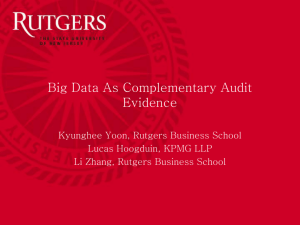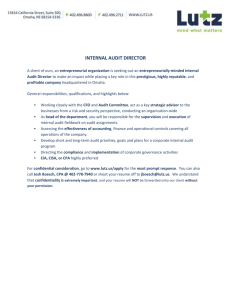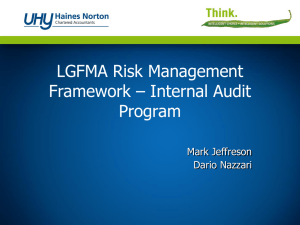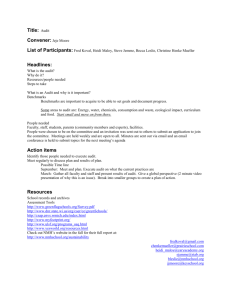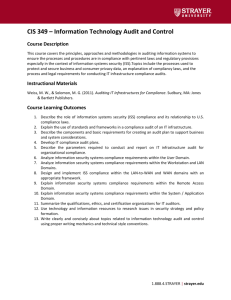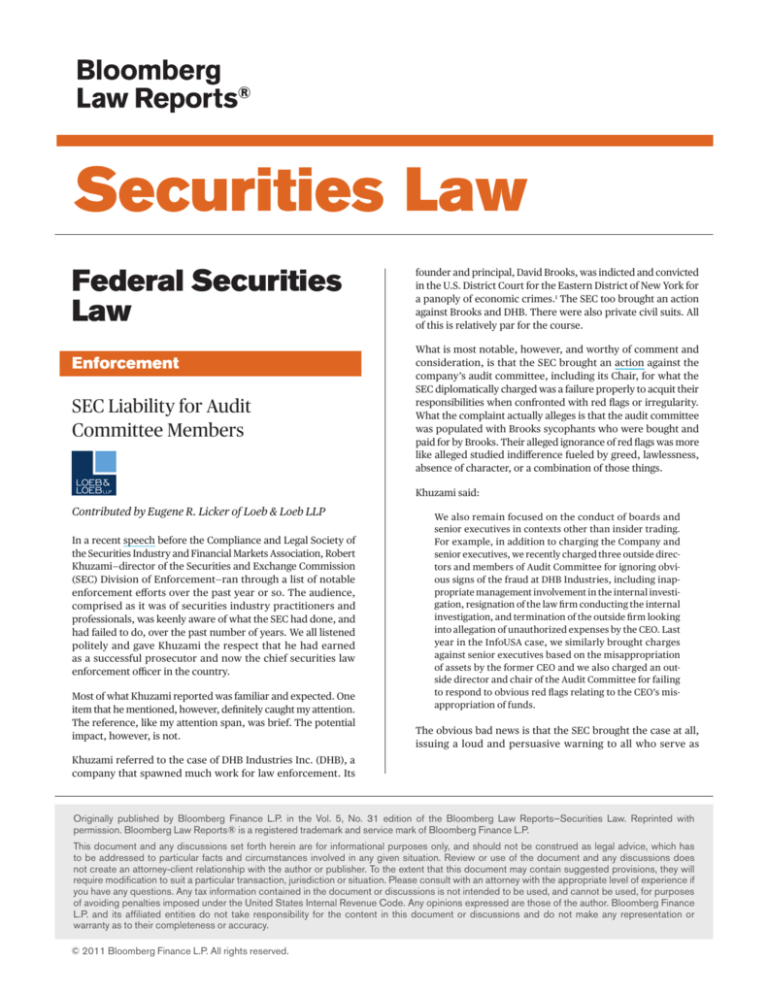
Securities Law
Federal Securities
Law
Enforcement
SEC Liability for Audit
Committee Members
founder and principal, David Brooks, was indicted and convicted
in the U.S. District Court for the Eastern District of New York for
a panoply of economic crimes.1 The SEC too brought an action
against Brooks and DHB. There were also private civil suits. All
of this is relatively par for the course.
What is most notable, however, and worthy of comment and
consideration, is that the SEC brought an action against the
company’s audit committee, including its Chair, for what the
SEC diplomatically charged was a failure properly to acquit their
responsibilities when confronted with red flags or irregularity.
What the complaint actually alleges is that the audit committee
was populated with Brooks sycophants who were bought and
paid for by Brooks. Their alleged ignorance of red flags was more
like alleged studied indifference fueled by greed, lawlessness,
absence of character, or a combination of those things.
Khuzami said:
Contributed by Eugene R. Licker of Loeb & Loeb LLP
In a recent speech before the Compliance and Legal Society of
the Securities Industry and Financial Markets Association, Robert
Khuzami—director of the Securities and Exchange Commission
(SEC) Division of Enforcement—ran through a list of notable
enforcement efforts over the past year or so. The audience,
comprised as it was of securities industry practitioners and
professionals, was keenly aware of what the SEC had done, and
had failed to do, over the past number of years. We all listened
politely and gave Khuzami the respect that he had earned
as a successful prosecutor and now the chief securities law
enforcement officer in the country.
Most of what Khuzami reported was familiar and expected. One
item that he mentioned, however, definitely caught my attention.
The reference, like my attention span, was brief. The potential
impact, however, is not.
We also remain focused on the conduct of boards and
senior executives in contexts other than insider trading.
For example, in addition to charging the Company and
senior executives, we recently charged three outside directors and members of Audit Committee for ignoring obvious signs of the fraud at DHB Industries, including inappropriate management involvement in the internal investigation, resignation of the law firm conducting the internal
investigation, and termination of the outside firm looking
into allegation of unauthorized expenses by the CEO. Last
year in the InfoUSA case, we similarly brought charges
against senior executives based on the misappropriation
of assets by the former CEO and we also charged an outside director and chair of the Audit Committee for failing
to respond to obvious red flags relating to the CEO’s misappropriation of funds.
The obvious bad news is that the SEC brought the case at all,
issuing a loud and persuasive warning to all who serve as
Khuzami referred to the case of DHB Industries Inc. (DHB), a
company that spawned much work for law enforcement. Its
Originally published by Bloomberg Finance L.P. in the Vol. 5, No. 31 edition of the Bloomberg Law Reports—Securities Law. Reprinted with
permission. Bloomberg Law Reports® is a registered trademark and service mark of Bloomberg Finance L.P.
This document and any discussions set forth herein are for informational purposes only, and should not be construed as legal advice, which has
to be addressed to particular facts and circumstances involved in any given situation. Review or use of the document and any discussions does
not create an attorney‐client relationship with the author or publisher. To the extent that this document may contain suggested provisions, they will
require modification to suit a particular transaction, jurisdiction or situation. Please consult with an attorney with the appropriate level of experience if
you have any questions. Any tax information contained in the document or discussions is not intended to be used, and cannot be used, for purposes
of avoiding penalties imposed under the United States Internal Revenue Code. Any opinions expressed are those of the author. Bloomberg Finance
L.P. and its affiliated entities do not take responsibility for the content in this document or discussions and do not make any representation or
warranty as to their completeness or accuracy.
© 2011 Bloomberg Finance L.P. All rights reserved.
2
Securities
Law
corporate watchdogs. The good news is that the alleged behavior
here was so egregious as to set, what one can only hope is, a very
high (or low, depending on how you look at it) bar for future cases.
The Audit Committee and
Independent Investigations
Every public corporation has an audit committee. It is populated
by independent directors—a defined, technical term—and has,
among other things, purview over the retention and conduct
of the company’s outside auditors. For that reason, the
members of the audit committee should have familiarity with
the audit process, and the Chair should have an accounting
background. One member of the audit committee is designated
the “financial expert.”
The audit committee, however, has additional responsibilities.
As an adjunct to serving as the overseers of the annual audit,
the audit committee serves as corporate watchdog, supposedly
ever vigilant to indications of wrongdoing or even irregularity.
When some such indication comes to its attention, the audit
committee must investigate.
Investigations have become a way of life for the defense bar.
Long ago, it became clear that corporate survival hinged on what
prosecutors and other law enforcement personnel refer to as
“good corporate citizenship.” It made itself clear to me in the
late 1980’s and early 1990’s through a series of circumstances in
which companies that rallied support for key personnel under
attack ended up going out of business, and those who jettisoned
accused personnel and cooperated with the government had
a chance for survival. The practice naturally was nurtured by
law enforcement and grew to the point where the government
labeled as the dreaded “non-cooperation” such venal acts as
asserting the attorney client privilege and paying for counsel
for personnel under attack. Things moderated a bit after law
enforcement and KPMG LLP met in Judge Kaplan’s courtroom,
but the idea of corporate cooperation persists.
Cooperating companies, and their counsel, should not be too
harshly blamed for their failure to support their employees who
are under attack. The stakes are just too high. A RICO indictment—
charges, not conviction—is enough to dry up short term borrowing
and put a company out of business. A conviction presents the
very real prospect of draconian remedies under the sentencing
guidelines,2 not to mention the adverse publicity and all that
goes with that. Once in the prosecutor’s cross hairs, a corporate
target has no real option but to cooperate.
In this context, cooperation means a number of things, but the
primary tool—especially after Judge Kaplan’s ruling in the KPMG
case (which should be required reading in every criminal law
class)—of the trade is the internal or independent investigation.
Usually conducted under the auspices of the audit committee, in
an independent investigation, a law firm with no prior connection
to the company is retained to investigate the allegations, usually
identified in a scope memo and implemented through execution
of an action plan. The law firm hires forensic accountants and
goes to work. The SEC, the US Attorney’s office, or both, are
informed of the investigation, the scope, and possibly the action
plan. Usually, the government is kept apprised at some level of
the progress of the investigation. At some point, the company
makes the decision as to whether or not to reveal the findings
to the government.
Aside from the estimable fact that there is, arguably, no alternative
course, the independent investigation, properly and seriously
done, is an effective tool for all concerned. For the company,
it offers perhaps the only possibility of survival. Moreover, in a
somewhat less cynical vein, the company has a strong interest in
ferreting out wrongdoing and determining how it happened in the
first instance so as to prevent its recurrence. For the government,
it can be win/win/win: the target undertakes the frequently
exhausting task of investigating the alleged wrongdoing and
usually turns the resulting work product over to the government;
the target bears the financial cost of the investigation; and if the
government is not satisfied with the results, it always has the
option of conducting its own investigation. All it stands to lose
is some time, and the government is not at all bashful about
pressing the investigators to move quickly.
As with anything, however, there are always going to be those
who feel they can manipulate or skirt the system. Which leads
us to Brooks and DHB. Always considered something of a two
edged sword, the independent investigation now, in light of the
DHB case, takes on an additional, and very sharp, down side edge.
DHB
Brooks owned and ran DHB, a manufacturer of body armor. It
doubtlessly did not help Brooks’ profile with law enforcement
that he plied his wrongdoings through, and at the expense of,
a company whose mission was to protect U.S. servicemen and
police and became immensely profitable after the tragic events
of September 11, 2001. Brooks also controlled a company called
Tactical Armor Products (TAP), nominally owned by his wife.
TAP made the armor plates that went into the body armor vests
made by DHB.
On October 25, 2007, the SEC sued Brooks in federal court
in Florida, alleging that he had engaged in accounting fraud,
misappropriation of corporate funds, and insider trading, as
well as aided and abetted DHB’s violations. The Department
of Justice (DOJ) brought criminal charges against Brooks in
New York for securities fraud, conspiracy, insider trading, and
obstructing justice.
The laundry list of Brooks’ offensive conduct is long and fairly
familiar. It included technical accounting violations, such as
misclassified expenses, and more common charges such as
expensing as business costs millions of dollars of expenditures for
Brooks’ personal expenses. Paragraph two of the SEC’s complaint
against DHB alleges:
DHB’s lack of internal accounting and financial reporting controls allowed senior management and others to
3
Securities
Law
manipulate the Company’s reported gross profit, net
income, and other key figures in its earnings releases and
public filings. They did so by overstating inventory values,
failing to include appropriate charges for obsolete inventory, and falsifying journal entries.
Brooks is alleged to have fraudulently transferred more than
$10 million for his own benefit. The suits against Brooks and
the company were in addition to the previous action, filed by
the SEC on August 17, 2006, against DHB’s former CFO, Dawn
Schlegel, and its former COO, Sandra Hatfield, alleging that they
aided and abetted DHB’s violations regarding reporting, books
and records, and internal controls, as well as their own conduct
in violation of the antifraud provisions of the securities laws. The
DOJ followed with similar criminal charges.
But even with that clean sweep of senior management, law
enforcement was not through with this company and its
personnel, and that is what gives rise to this cautionary tale. As
so often is the case, it was not ( just) the crime that garnered the
attention of law enforcement. It was the cover up.
The alleged conduct is so
egregious as to give future putative
defendants a lot of room to argue
for the exercise in prosecutorial
discretion to the extent their
alleged conduct does not meet
this high bar of malfeasance.
The DHB Audit Committee
As noted above, the audit committee deals with the corporation’s
outside auditors in the conduct of annual audits and periodic
reviews, and just as the audit is independent, so too are the audit
committee members. That means that, unlike others on the board
of directors, they are not part of the management of the company
nor are they tied to management in any meaningful way. The audit
committee members are supposed to be unafraid to confront
and police management. They are the corporation’s watchdogs.
The SEC, upon investigation and reflection, concluded that the
DHB audit committee did not serve its role well in any respect.
The SEC does not believe that the DHB audit committee members
were independent of Brooks, nor does it think that the committee
was even trying to do its watchdog job. If the allegations in
the complaint are true, the SEC most certainly is correct on
both counts.
DHB’s audit committee was comprised of Jerome Krantz, Cary
Chasin, and Gary Nadelman. They also constituted the company’s
compensation committee. According to the complaint against
them, Krantz was a director and Chair of the audit committee
from 2000 through May 2006 and was the owner of an insurance
agency and financial consulting firm. Chasin served as a director
and audit committee member from October 2002 through
February 2007 and was an employee of DHB for several months
in 1997 and again from November 1999 through April 2000.
Nadelman was a director and audit committee member from
November 1995 through August 2000 and again from July 2001
through February 2007.
The SEC alleges that, far from being independent, these three
men were longtime friends and neighbors of Brooks who
depended on Brooks for financial support and were entirely
dominated by him. All three were alleged to have business
relationships with Brooks. Krantz was his insurance agent.
Chasin previously worked at DHB, which was his sole source of
income from 1997 to 2000. Nadelman is alleged to have been a
“significant investor” in a private company in large part owned
and later taken public by Brooks. The three were alleged to have
received “lucrative warrants” in 2003, 2004, and 2005, as well
as other perquisites. In an interesting, and likely artful, pleading,
immediately following the allegations of financial rewards given
by Brooks to the three members of the audit committee, the SEC
inserts the nearly obligatory salacious allegation: “Additionally,
the three directors knew the Company was paying for services
with no legitimate business purpose, such as prostitutes.” The
beneficiaries of this particular largess are not identified, other
than by innuendo.
The Committee’s Alleged Failures
As noted above, the good news coming out of this case is the
extreme conduct, by omission and commission, in which the
committee allegedly engaged. According to the complaint, at
virtually every turn the committee failed properly to acquit its
responsibilities, engaged in conscious avoidance of important red
flags, allowed Brooks to control and subvert what should have
been the investigative and protective process, or joined him in
the wrongdoing. The alleged conduct is so egregious as to give
future putative defendants a lot of room to argue for the exercise
in prosecutorial discretion to the extent their alleged conduct
does not meet this high bar of malfeasance.
——Failure to Understand Their Responsibilities
DHB’s public and internal documents lay out the familiar
litany of responsibilities of the audit committee, including
monitoring financial reporting and internal controls. In a virtually
ipse dixit allegation, the SEC claims that the members of the
committee “made little or no effort even to understand their”
responsibilities.3
4
Securities
Law
——Failure to Heed Red Flags
The complaint details a long list of red flags that, according to
the SEC, should have alerted the three defendants to the fact that
Brooks was engaging in fraud. In this regard, the complaint is
essentially facetious. It is unlikely that the SEC really believes that
the committee members either missed these indications or failed
to appreciate them as opposed to intentionally allowing Brooks
to get away with wrongdoing in return for personal financial
reward. In any event, the alleged litany of unheeded red flags, if
proven, makes out an overwhelming case.
——The Parade of Auditors
In the five years between 2002 and 2006, DHB had an astounding
four, or five if you count the doubling up (more on that later),
different auditing firms. Grant Thornton LLP resigned on August
20, 2003. It was replaced by Weiser LLP, which resigned on April
8, 2005. Next came Rachlin Cohen and Hotz, P.A. (Rachlin). There
is no allegation that Rachlin resigned, but there is an allegation
that after Rachlin issued a statement pursuant to Section 10A
of the Securities Exchange Act of 1934 on April 5, 3006, DHB
(acting through Chasin) engaged Russell Bedford Stefano LLP to
reaudit its 2003 and 2004 financials, which Rachlin was in the
midst of doing. Shortly thereafter, in August 2006, the SEC and
the U.S. Attorney’s Office began commencing actions against
DHB personnel.
——The Auditors’ Actions
The multiple resignations were red flags in and of themselves, but
the actions allegedly taken by the auditors during their truncated
tenures constituted red flags as well:
• On July 2, 2003, Grant Thornton directed to
Krantz specific questions regarding interested
party transactions;
• On the day it resigned (August 20, 2003), Grant
Thornton issued a material weakness letter
regarding DHB’s financial reporting controls;
• In February 2005, after it had resigned, Grant
Thornton complained to Krantz that it had not
been told of an important board resolution
that supposedly had been adopted in 1997 and
threatened to withdraw its 2002 audit opinion;
• In March 2004, Weiser raised concerns about DHB
accounting;
• Shortly thereafter, Weiser recommended the
hiring of “a CFO for the Florida operation, a
Director of Financial Reporting, a cost accountant
responsible for inventory cost accounting and
reporting,” and told the committee to replace
Krantz as audit committee financial expert;
• In February 2005, Weiser met with the audit
committee to discuss certain allegations raised by
the Controller, telling the committee to investigate
these matters;
• In that same meeting, Weiser told the committee
that it intended to issue a material weakness letter,
which it did in March 2005;
• In March 2005, Weiser informed the company that
it could not rely on the 2004 annual audit report;
• In November 2005, Weiser refused to allow DHB
to re-issue Weiser’s audit reports; and
• On April 5, 2006, Rachlin sent DHB, the
committee, and the SEC a Section l0A letter
reporting potentially illegal acts.
——The Investigations
Just as there were multiple auditors, there were multiple
investigators. Gibson Dunn and Crutcher, LLP had been retained
in June 2003 to investigate possible related party transactions.
In January 2004, the audit committee learned that Gibson
had resigned. On February 9, 2004, Brooks hired Pepper
Hamilton LLP and FTI Consulting, Inc. (FTI) to continue the
investigation. FTI raised issues regarding Brooks’ misuse of
corporate assets and other matters, and in July 2004 Brooks
terminated FTI. The Complaint does not address the fate of
Pepper Hamilton’s engagement.
Moreover, not only did Brooks exercise a unilateral veto with
regard to the investigations, each time one was commenced, he,
rather than the audit committee, controlled it. Thus, he allegedly
refused to provide information despite repeated requests from the
investigators. He also allegedly directed the scope and conduct
of the investigations, the manner of reporting, the identity of
witnesses, and the like. In short, the investigations were in no
way independent and, according to the SEC, they had absolutely
no integrity.
——Additional Complaints and Accusations
In addition to the questions and allegations raised by the auditors
and the investigators, others put the audit committee on notice
that something was amiss. In 2003, the Union of Needletrades,
Industrial and Textile Employees raised possible disclosure issues.
In early 2004, the SEC served a subpoena on DHB telegraphing its
concerns about possible related party transactions. In February
2005, the company’s recently-hired Controller raised issues with
regard to accounting for inventory and said he was going to resign.
Before the Controller could resign, however, Brooks fired him.
5
Securities
Law
——Participation in Wrongdoing, Including
Sham Investigations
Whether viewed as a failure to heed red flags, as the SEC primarily
casts it in its complaint, or viewed as complicity in wrongdoing,
the SEC alleges that the audit committee let Brooks get away
with the financial equivalent of murder. As noted above, when
allegations were raised by the various sources, DHB turned
matters on their head. Under the guise of conducting an
independent investigation of the allegations, which usually would
be conducted under the auspices of the audit committee, the
investigations were allegedly controlled by Brooks and were, for
that reason, nothing more than a sham. According to the SEC,
the audit committee had clear evidence that Brooks was using
corporate assets for his personal benefit, yet it did nothing to stop
the practice. Indeed, the SEC believes that Brooks manufactured
a non-existent, after-the-fact corporate resolution in an attempt
to justify his defalcations, and alleges that he enlisted the aid
of audit committee members to provide a façade of legitimacy
for his ruse.
The Case
The SEC commenced its action on February 28, 2011. Because all
three of the defendants served as directors of the company, and
signed the public filings, they were each charged with substantive
violations of the securities laws. They each allegedly knew that
the company’s public filings were false. The vast bulk of the
allegations, however, are cast in terms of aiding and abetting
Brooks’ wrongdoings. Of course, the SEC could have pled the case
differently, placing emphasis on the claims of direct responsibility
for securities fraud. By relying almost entirely on accessorial
liability, however, it appears, at least to me, that the SEC is sending
a loud and clear message: the audit committee is supposed to be
the sheriff; if it is not going to serve that role, then its members
are going to find themselves, figuratively speaking, on the wrong
side of the cell, sharing it with the people whose misconduct they
are empowering by failing to do their job.
The case is currently pending in federal district court in Florida.
Very little has occurred in the case.
As befits a complaint pre-ordained for settlement, the Raval
complaint is not nearly as detailed as the DHB complaint. The SEC
alleged that the audit committee was informed of, and supposedly
investigated the propriety of, a number of interested party
transactions, and that Raval’s investigation of the transactions did
not reveal sufficient justification for at least some of the expenses.4
Raval was exposed to other red flags, including information
supplied to him by the head of internal audit and, later, after the
head of internal audit was fired, by his replacement. Disclosure
counsel also brought matters to Raval’s attention.
Rather than taking corrective action, Raval wrote a report.
The complaint does not describe or attach the report, but the
implication is that while the report did not exonerate Gupta,
it clearly did not provide the stinging revelations that the SEC
thought were called for under the circumstances. The SEC
thus sued.
Although the actions against Raval and against the DHB audit
committee are similar in nature, and to some degree content,
the two cases appear to send very different messages through
their tone and tenor. The causes of action in the Raval case sound
primarily in direct liability rather than accessorial liability. The
charges were simple and straightforward—securities fraud
and supervisory liability. Neither the rhetoric nor the charges
themselves seemed designed to broadcast to similarly situated
persons that the SEC would keep a keen eye out for a failure
adequately to acquit audit committee duties. Moreover, no
members of the audit committee other than Raval were named
or even was made the subject of attention or criticism. Finally,
although there most certainly are in the Raval complaint
references to the committee’s responsibilities, the rhetoric in
the DHB complaint is far more charged and pointed.
As noted above, Raval consented to the entry of judgment against
him. He was fined $50,000 and took a five year bar from serving
as an officer or director of a public company. No criminal charges
were filed. The penalties that result from a consent decree are,
and should be, more lenient than a litigated case. No one would
deny, however, that the relief obtained against Raval pales in
comparison to the relief sought against the DHB defendants.
——The Road Ahead
InfoUSA—the “Other” Case
In tone and content, the complaint against the DHB audit
committee members is unique and unprecedented. It is not,
however, the only case brought by the SEC against an audit
committee member who failed to acquit his responsibilities
properly. In March 2010, the Denver Regional Office of the SEC
commenced, and settled, an action against Vasant Raval, Chair of
the audit committee of InfoUSA. The story is familiar. The CEO of
InfoUSA, Vinod Gupta, used corporate assets for personal benefits
and engaged in interested party transactions. Raval, as Chair of
the audit committee, ignored red flags and allowed Gupta to run
amuck. He also signed public filings, knowing they were not true.
In a recent conversation, an SEC Enforcement Division Staff
Attorney explained to me that his less than patient attitude with
my client reflected the approach of the “New SEC.” I did not
quiz him about what that meant, to me or my client or even to
him, because I suspect that I know the answer. There has been
something of a sea change at the SEC over the last couple of years.
Some of it results from a natural progression due to a changing
of the guard. Some results from a reasonable response to the
chilling stimuli of horrendous economic conditions, inefficient
and flawed (and perhaps fraudulent) markets, and unparalleled
fraudulent conduct. Much of it results from the abject failure of
the SEC to detect or prevent the fallout from all of this.
Securities
Law
The SEC, however, is a proud and prestigious organization
charged with obviously serious responsibility and peopled with
quality personnel. Its current leadership is outstanding and its
commitment is unquestioned.
All of this clearly portends in favor of more rigorous enforcement
in general and, with regard to audit committee Chairs and
members, a greater emphasis by the SEC on ensuring that these
folks take their jobs seriously and do them well. Like the auditors
with whom they interface, audit committee members must be
skeptics, must ask the hard questions, must question the answers,
and must demand proof. There is nothing new about that, but
what is new is that a failure to do so seems more likely now to
attract attention than in days gone by.
Once again, the DHB facts, as well as the Raval facts, are extreme.
If the alleged (and in Raval, admitted) conduct took place, then
the defendants were more than remiss, they were complicit.
It does not take a great deal of imagination, or a crystal ball,
however, to foresee the SEC pursuing less egregious cases,
especially where studied indifference to red flags is coupled
with economic incentive to do so. As a result, it seems likely that
it will become harder to find people willing to serve on audit
committees, and most assuredly corporations will have to offer
greater financial incentives to offset the greater liability horizon.
We are already seeing all of that as audit committee members find
themselves more and more often named as defendants in civil
suits. It all makes one wonder what happens when prospective
audit committee members uniformly decide it is just not worth it.
Eugene R. Licker is Co-Chair of Loeb & Loeb LLP’s White Collar
Criminal Defense and Investigations Practice Group. He regularly
represents individuals and entities in criminal, SEC, and other
governmental and regulatory investigations and proceedings in
matters relating to securities and other fraud, tax evasion, and
other alleged misconduct. Mr. Licker has represented numerous
audit committees and others in connection with internal or
independent investigations.
1
By way of full disclosure, I should point out that Brooks interviewed me and
others from my firm in consideration of retaining us to represent him in his
criminal case. We were not, however, retained. Nothing addressed here is
based on any privileged information, nor does the fact that our firm was considered have any effect on this article.
2
Though no longer mandatory, the sentencing guidelines are routinely followed by most courts.
3
The factual averments regarding the defendants’ backgrounds do not provide a basis by which to judge their accounting acumen, although each is
alleged to have held positions that would indicate some level of financial
sophistication. Krantz was the designated “financial expert.”
4
Ironically, this information was supplied to the audit committee as part of a
newly-adopted compliance policy.
6



